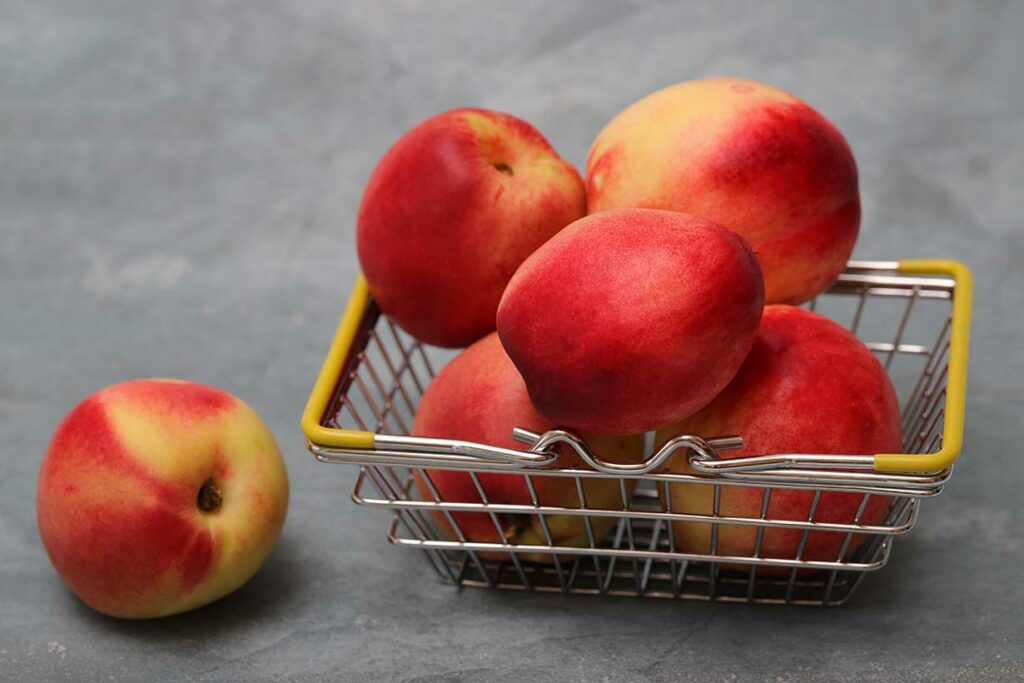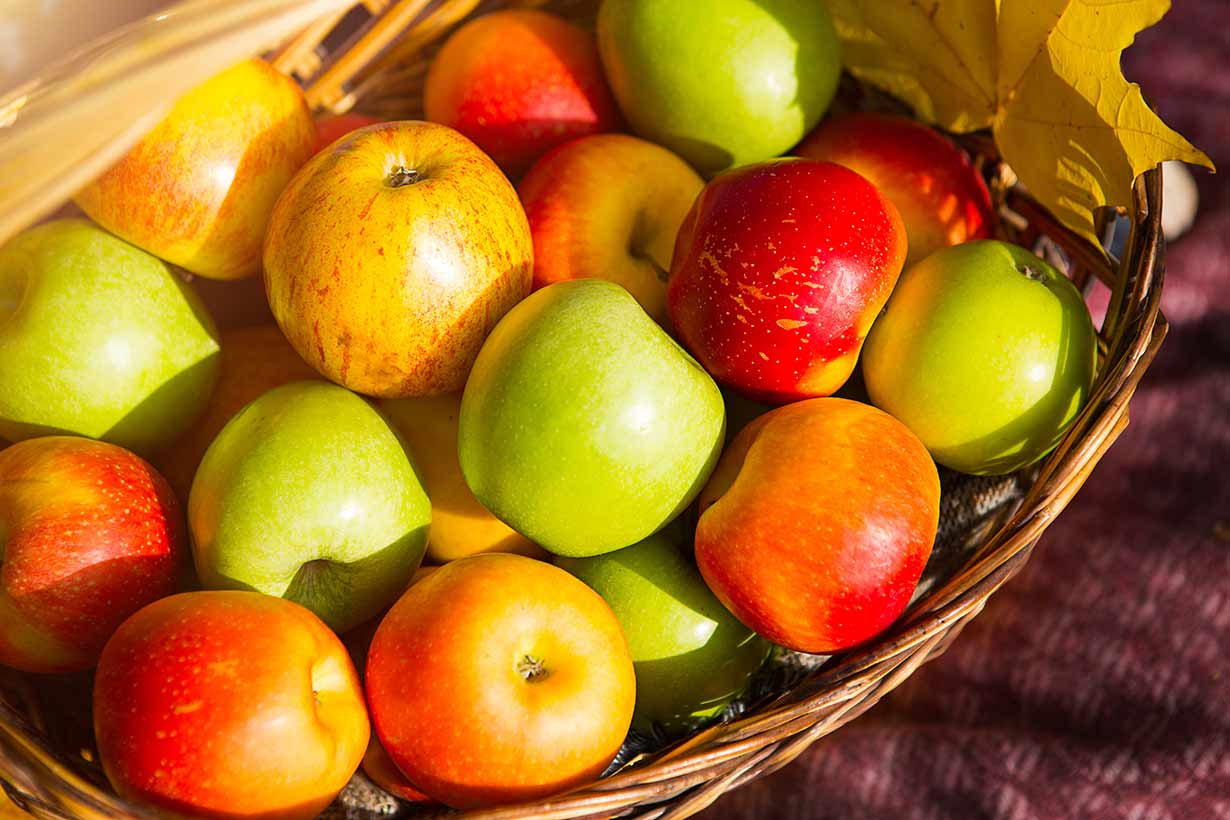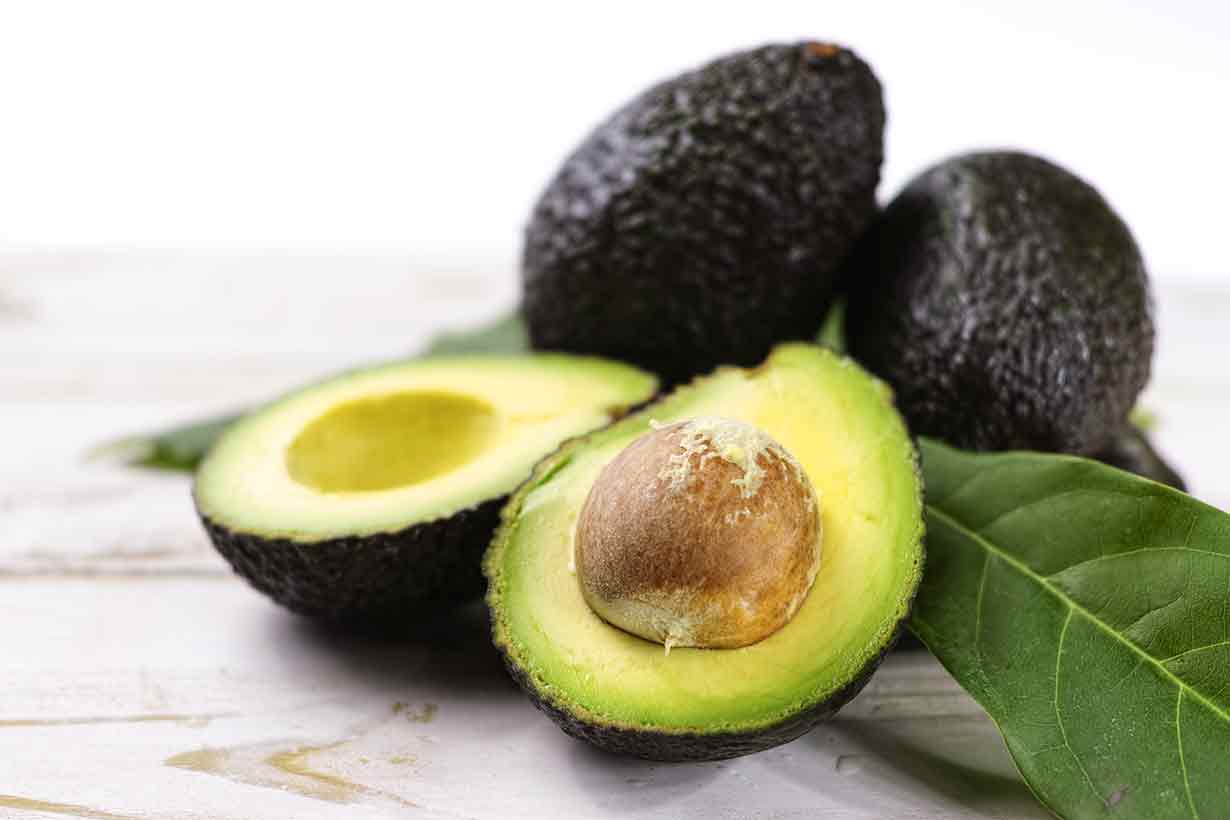Nectarine is a popular summer fruit that enjoys popularity around the world.
Nectarines are juicy and deliver a delicious taste, but what do they offer nutritionally?
This article reviews the nutritional values and potential benefits of nectarines.
Table of contents
What Are Nectarines?

Nectarines grow on the Prunus Persica tree, which is native to China but now grows worldwide (1).
The fruit is sweet and juicy, with a water content of 89%, and it has a pit (stone) in the middle (2).
Due to the water content of nectarines, they are a popular summer fruit on hot days.
Nectarines are very similar to peaches nutritionally and in appearance and flavor.
The two fruit have some subtle differences. For instance, peaches have fuzzy (or ‘hairy’) skin, whereas nectarines are smooth.
Additionally, nectarines have a slightly firmer texture. The flavor of nectarines and peaches also has some very slight differences, but the two taste so similar that they are hard to tell apart.
Regarding their appearance, nectarines usually have deep red skin with yellow or white flesh. However, some varieties of nectarines have blood-red flesh, earning them the nickname ‘blood nectarines’ (3).
Nectarines were domesticated thousands of years ago in China. While they now grow across all continents, China remains the leader in global production, followed by the EU, United States, and Turkey (4).
Nutritional Values
The following data sourced from the USDA’s FoodData Central database shows the nutritional values for a medium nectarine, with a typical weight of 142 grams (2).
Daily values for vitamins and minerals have been calculated using the USDA data and the FDA’s daily values (2, 5).
| Name | Amount | % Daily Value (% DV) |
|---|---|---|
| Calories | 63 kcal | |
| Carbohydrates | 15.1 g | 5.5% |
| Fiber | 2.41 g | 8.6% |
| Sugars | 11.2 g | |
| Fat | 0.45 g | 0.6% |
| Saturated | 0.04 g | 0.2% |
| Monounsaturated | 0.13 g | |
| Polyunsaturated | 0.16 g | |
| Omega-3 | 0.003 g | |
| Omega-6 | 0.16 g | |
| Protein | 1.5 g | 3% DV |
Nectarines provide carbohydrates and a moderate amount of fiber. However, they are not among the most fiber-rich fruit.
Vitamins
- Thiamin (B1): 4.2% of the daily value (DV)
- Riboflavin (B2): 3.1% DV
- Niacin (B3): 10% DV
- Pantothenic acid (B5): 5.2% DV
- Vitamin B6: 2.4% DV
- Choline: 1.6% DV
- Folate: 1.8% DV
- Vitamin A, RAE: 2.7% DV
- Vitamin C: 8.5% DV
- Vitamin E: 7.3% DV
- Vitamin K: 2.6% DV
Nectarines provide a good range of vitamins in small to moderate amounts. Among these, vitamins C and E are present in the highest amounts.
Minerals
- Calcium: 0.7% DV
- Copper: 13.3% DV
- Iron: 2.2% DV
- Magnesium: 3.0% DV
- Manganese: 3.5% DV
- Phosphorus: 3.0% DV
- Potassium: 6.1% DV
- Zinc: 2.2% DV
Nectarines are a good source of copper and potassium, and they contain small amounts of numerous other minerals.
Benefits
Here is an overview of some of the main benefits that nectarines offer.
1) A Good Source of Potassium
Potassium is an essential mineral that plays a vital role in regulating blood pressure. For this reason, consuming too little potassium can lead to higher blood pressure (6).
However, most people do not consume enough dietary potassium. For example, the prevalence rate of hypokalemia was 11.06% in the United States in 2016 (7).
Hypokalemia refers to having low levels of potassium in the bloodstream.
A medium-sized nectarine offers 285 mg of potassium, equivalent to 6.1% of the recommended daily value (4,700 mg) for the mineral (2).
Thus, adding nectarine into the diet is a simple way to help contribute to potassium needs.
Note: while nectarines offer moderate amounts of potassium, avocados and bananas offer even more per fruit.
2) Nectarines Provide Vitamin C
With a typical vitamin C content of 7.67 mg per medium fruit, nectarines provide 8.5% of the recommended daily value of 90 mg (2).
Vitamin C is an essential vitamin that plays an important role in the immune system, collagen production, and keeping cells healthy (8).
Note: for more vitamin C sources, tropical fruit like mango and papaya provide significant levels.
3) Nectarines Have a Low Glycemic Index
The glycemic index of foods rates each food with a score between 0 and 100, based on how that food can impact blood sugar levels. For example, a score of 0 would mean a minimal impact on blood sugar, whereas a score of 100 is equal to pure glucose.
Once we have the glycemic index of a food, we can calculate the glycemic load.
The glycemic load can accurately estimate the extent of blood sugar rise after consuming a particular food. We can calculate glycemic load by multiplying the glycemic index score by the number of carbohydrates in a portion of food and then dividing the total by 100.
On this note, nectarines have a low glycemic index.
According to the University of Sydney’s Glycemic Index database, nectarines have a glycemic index of 43. Additionally, they have a glycemic load of only 6 (9).
In other words, nectarines only have a minimal impact on blood glucose levels. Therefore, the fruit is an acceptable choice for individuals following diets focusing on low-glycemic foods.
4) High In Bioactive Polyphenols
A 2017 study published in the Journal of Science and Food Agriculture examined the polyphenols found within stone fruit (10).
As part of this study, the researchers profiled six different stone fruit:
- Apricot
- Cherry
- Flat peach
- Peach
- Plum
- Nectarine
Interestingly, nectarines had the highest flavonoid and total phenol content among these six stone fruit (10).
Furthermore, a 2019 study published in the Journal of Food Science and Technology examined nectarines’ chemical and nutritional properties (11).
The study determined that nectarines are a significant source of phenolic acids, which are types of polyphenols. The main phenolic acid present is called chlorogenic acid.
More research is necessary to understand the potential benefits and mechanisms of polyphenols fully. However, it is thought that dietary patterns that include high amounts of these compounds can benefit human health.
In this regard, a 2019 systematic review of the existing scientific literature examined the relationship between polyphenol intake and health outcomes. The review found that many available studies find an association between polyphenol intake and lower all-cause mortality. The researchers concluded that the available data strongly supports the health-protective effect of dietary polyphenol intake (12).
Potential Downsides
Nectarines are a low-calorie fruit with a decent nutrient profile and a delicious taste, and there are not many downsides to nectarine consumption.
There is a rare risk of allergy to nectarine – any food and any fruit can cause an allergic reaction, including nectarine (13).
In one case report, a 70-year-old man suffered anaphylactic shock (severe allergic reaction) after consuming nectarine (14).
Additionally, some people have a stone fruit allergy, and the different fruits (peach, nectarine, plum, etc) within this category can have allergic cross-reactivity (15, 16).
However, it should be noted that there are very few reports in the scientific literature on nectarine allergy, and it appears to be relatively rare.
Anyone with a suspected nectarine or stone fruit allergy should discuss it with their medical doctor/team.
How To Use Nectarines
There are many ways we can use nectarines, from simply eating the fruit whole to cooked recipes.
Here are some different ideas:
- Eat the fruit whole as a snack
- Chop the nectarine into pieces and top with cream for a simple but tasty dessert
- Make a nectarine salad with leafy greens of choice (e.g. lettuce/spinach), feta cheese (or cheese of choice), sliced nectarines, sliced red onions, sesame seeds, pine nuts, olive oil, balsamic vinegar, and salt to taste
- Chop the nectarine into small pieces and add to yogurt alongside some mixed nuts
- For those who prefer sweet things occasionally, there is also a wide range of nectarine dessert recipes
Final Thoughts
Nectarines are a delicious, sweet, and juicy summer fruit that people enjoy globally.
Nutritionally, nectarines are not among the most nutrient-rich fruit, but they offer a good source of vitamin C, potassium, and copper.
However, nectarines may also offer further benefits from their high content of flavonoid and phenolic acid polyphenols.
Overall, they are an enjoyable and refreshing fruit that can help to provide our diet with some essential nutrients.








